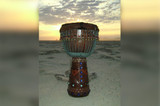How to Tune Bongos
Bongos are one of the most versatile and portable hand drums available today. These percussion instruments are played by professionals and amateurs, on the road, in a drum circle, on stage or even in the home. As versatile and adaptive as these drums are, there are basic steps that should be taken to ensure the longevity of the bongos and quality of sound.
In general, a new set of bongos will not come pre-tuned due to shipping and the time spent on shelves, as well as various weather-related factors. For the new bongocero, the difference between a well-tuned set and the sound straight out of the box may not noticeable, so it is recommended that the bongos are tuned professionally. For more experienced drummers and musicians, tuning the bongos may be an immediate concern, enabling the drums’ best sound and pitch.
To tune the bongos, start with loosening the heads by unscrewing the lugs, about a quarter turn each, until the rim is loose and able to move freely. Then, replace the rim and tighten the lugs by hand until they hold the rim in place firmly. Next, begin with the smaller of the drums, the macho, and tighten one of the lugs closest to the block affixed between the drums about a quarter of a turn, moving to the next lug until all are tight. The bigger drum, or hembra, is next and should be tuned in the same manner. Always be sure to pay attention to the pitch difference between the drums, as the best interval is about an octave, with the macho’s tone remaining crisp and clean.
When tightening the lugs, if there is too much tension while tightening or they squeak while turning, apply a lubricant to help keep the hardware in its best condition. De-tuning the bongos is also recommended between playing in order to reduce tension from the shells. De-tune your bongos in the reverse order in which they were tuned, by loosening the last lug tightened, following with the remaining lugs in a circular pattern.
Keeping bongos in perfect shape can make a big difference in the sound, playability and longevity of the drums. By tuning, and de-tuning, these drums, the ability to keep on drumming on stage or in a drum circle will last for many years to come.
Recent Posts
-
What is the Best Size Djembe for Beginners?
If you're new to the world of percussion and interested in learning the djembe, you're in for a t …16th Jul 2024 -
The Benefits of Becoming a Drumming Teacher: Transforming Passion into Profession
Why become a drumming teacher? Becoming a drumming teacher is an excellent way to share your pas …22nd May 2024 -
What Makes the Djembe Drum a Spiritual Instrument in African Music?
Origin and history of the Djembe drum The Djembe drum originates from West Africa and holds sign …16th May 2024



